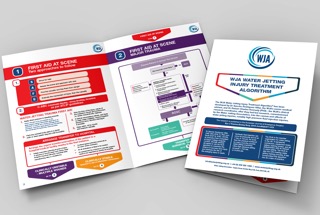A study commissioned by the Water Jetting Association into the management of high pressure fluid injection injuries has been accessedonline10,000 times in four years.
It has also been cited in five specialist medical papers over the same period, making it one of the most important and widely-referenced research papers on the topic in the world.
Now, an injury treatment algorithm developed fromthe research, has been updated to make it easier to use.
The WJA Water Jetting Injury Treatment Algorithm gives step-by-step best practical guidance on the treatment of water jetting injuries from first response through to definitive hospital care.
It provides vital guidance for paramedics and clinicians,as well as water jetting contractors, which include pressure washing specialists, service commissioners and health and safety professionals.
The WJA is the member organisation for the water jetting industry in the UK. Its codes of practice and City & Guilds accredited training courses are respected for setting water jetting standards internationally.
Water jetting is commonly used for cleaning tubes and chambers in oil and gas, petrochemicals and energy plants, carrying out hydrodemolition of concrete structures, and cleaning culverts, tanks and sewers in drainage systems, as well other surface preparation, cleaning and materials cutting tasks.
The research the WJA funded was led by Dr Sancho Rodriguez-Villar, an intensive care consultant at Kings College Hospital, London, and Dr Robert Charles Kennedy (PhD), the WJA’s clinical research and development advisor.
DrRodriguez-Villar said: “The study is one of the most important sources of expert opinion on high pressure fluid injection injuries in the world. It is a complex multidisciplinary piece of research involving knowledge from industry and three medical specialties.
“Researchers and clinicians are clearly finding it useful. It is highly likely that doctors and surgeons around the world are searching for advice on such injuries, finding this research, and using it to guide their treatment.
“In this sense, it is having the desired and very important effect of educating clinical teams about how to treat these unique and serious injuries. This, in turn, will be greatly improving the treatment outcomes for patients, contributing to their long-term health and wellbeing.”
The study is called the Management of Industrial High Pressure Fluid Injection Injuries (IHPFII): the Water Jetting Association Experience with Water Driven Injuries.
It was published in the European Journal of Trauma and Emergency Surgery in March 2019, and is also available via the medical database Researchgate.
The injury treatment algorithm helpsfirst aiders, paramedics and clinicians optimise treatment, reducing the risk of death, long-term disability or unnecessarily prolonged periods of recovery.
The WJA has now created A4 version which is easier to view, both online and offline. Its sections have also been colour-coded so users can easily follow a patient’s journey through a treatment pathway.
It can be instantly accessed via a red tab on the home page of the WJA website.
IHPFII injuries can be caused with water pressures as low as 7 bar, or 100 pounds per square inch (PSI) – while water pressures for industrial applications can exceed 1,700 bar, or 24,650 psi.
They are characterised by small entry wounds, caused by fine fluid jets,and no exit wounds. This can mask the extensive internal disruption they can cause. Debris and bacteria can be also carried far into the body, increasing the risk of serious infection.
These factors can lead to delays in patients receiving the appropriate emergency treatment. This can result in complications that, in worst cases, cause life-changing serious injury or death.
Robert Kennedy said: “The evidence shows that, without early and correct intervention, the outcome for those injured is often catastrophic. We strongly advise all parties to observe the WJA’s algorithm for the management of high-pressure injection injuries.”
This article can also be found in the issues below.




